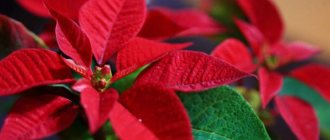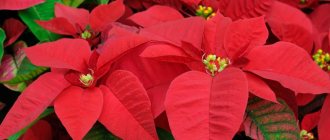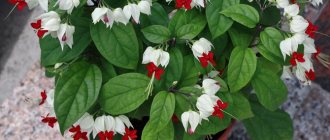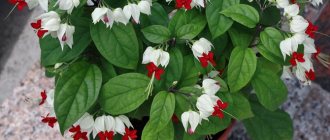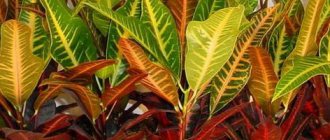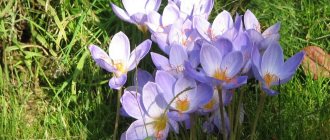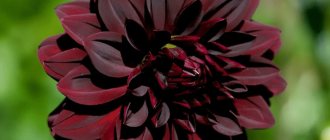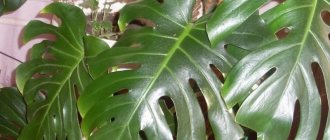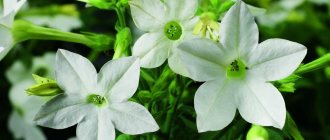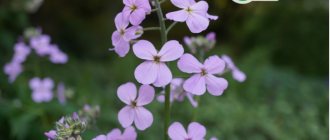Cordyline - indoor decorative flower with long red leaves
Cordyline fruticosa
This is an indoor flower with long red leaves up to 50 cm in length with red or red and white stripes. Cordyline australis has dense green leaves without petioles, some varieties with reddish or white stripes. In both species, the leaves gradually dry out from below - this is how trunks are formed.
Family: Agavaceae (Agave).
Homeland: India, New Zealand.
Location: This ornamental flower with red leaves likes light without direct sun, Cordyline australis prefers full sun.
Temperature: for Cordyline fruticosa - warm, Cordyline australis - cool.
Air humidity: ensure high humidity, spray more often.
Substrate: flower soil mixture; for Cordyline australis - with 1/3 sand.
Watering: Cordyline fruticosa - the soil should never dry out.
Feeding: once every 3 weeks, do not feed Cordyline australis in winter.
Transplantation: if necessary.
Reproduction: seeds, apical and stem cuttings.
Pests, diseases: red mite.
Important! Place Cordyline australis outside in partial shade in summer.
Look at this flower with red leaves in the photo, which illustrates its decorative capabilities:
Indoor flowers with red stems
Home indoor flower with purple leaves
Not only the foliage, but also the stems can be painted red, which is also quite original.
Kislitsa
Oxalis is distinguished by burgundy-purple foliage and equally bright stems. Typically the leaf shape is triangular, up to 4-5 cm in length. The shape of the oxalis leaf blade is similar to a clover leaf. Oxalis is saturated with oxalic acid salts, carotene, and vitamin B, so it is used in some dishes as a seasoning.
Kislitsa
The plant loves a lot of light, but it is still not worth leaving it in the open sun. It is better to place the pot of sorrel away from the window, but not in the darkest corner. The room should be cool, up to 25 °C, otherwise the plant will wither.
Important! The stems of the flower have the same color as the leaves, but the shoots that hold the flower stalks are green.
Houseplants with red foliage are guests from the tropics. Therefore, they require special conditions for good growth and abundant flowering. Before purchasing such a flower, carefully study the rules for caring for it and strictly follow them in the future.
Perennial flower with red leaves
Bloom's Coleus is a perennial flower with red leaves in the middle.
The velvety leaves with finely toothed edges can come in all colors from cream, green, pink and purple to fiery red. The patterns on them are as varied as the shapes. Almost exclusively garden forms and hybrids of Coleus Bloom are grown as indoor plants. This flower with red leaves in the middle blooms with inconspicuous blue flowers.
Look at this indoor flower with red leaves in the photo and remember the name of the crop:
Family: Lamiaceae (Lamiaceae).
Homeland: Tropical Asia and Africa.
Location: a perennial flower with red leaves prefers a sunny location, otherwise the leaves will not have beautiful color.
Temperature: room temperature, in winter not lower than 12 °C.
Air humidity: the warmer the room, the higher the air humidity should be.
Substrate: flower soil mixture.
Watering: Abundant in summer, more economical at low temperatures; do not allow the earthen clod to dry out.
Feeding: Weekly in summer.
Transplantation: If necessary.
Reproduction of Coleus Bloom: Cuttings in water.
Pests, diseases: Red mite.
Important! The tops of the shoots are regularly broken off for more luxuriant growth. In the summer, expose the coleus to the air, but in damp and at the same time cold weather, bring it indoors.
Cryptanthus - home flower with red leaves
Cryptanthus acaulis has wavy red, pink or brownish leaves covered with gray scales collected in star-like rosettes. Cryptanthus bivittatus is characterized by wavy leaves with two white or pink longitudinal stripes.
Family: Bromeliaceae (Bromeliaceae).
Homeland of Cryptanthus: Brazil.
Location of home flower with red leaves: Partial shade, sunny in winter.
Temperature: Not lower than 18 °C. The earth must be warm.
Humidity: Tolerates dry air, but prefers 60% humidity. Do not spray.
Substrate: Flower soil mixture with styrene chips or something else.
Watering: Economical - in a funnel.
Feeding: In summer, every 2 weeks with fertilizer at a 50% concentration.
Transplantation: If necessary.
Reproduction: Offshoots half the size of the mother plant.
Pests, diseases: Rare.
Important! Cryptanthus should not be planted on a tree trunk as an epiphyte; it will die. Cryptanthus looks very attractive in the “bottle garden” and has a variety of uses.
Carefully! Contains substances that irritate the skin.
The name of the indoor flower with green-red leaves is Hypestes phyllospica
Only one species is cultivated as a houseplant, Hypestes phyllospica, but there are many varieties. With age, the indoor flower with green-red leaves becomes large, but bare. Olive-colored leaves usually have pink-red or white spots. Small side shoots grow from the leaf axils. A flower with green-red leaves has one name; it has no synonyms.
Hypestes is usually cultivated as an annual.
Family: Acanthaceae (Acanthaceae).
Homeland: South Africa, Madagascar.
Location: Bright, direct sun for several hours a day.
Temperature: Room temperature, not lower than 15 °C.
Humidity: High. Do not spray.
Substrate: Flower soil mixture.
Watering: Maintain moisture in summer, but not damp; water less in winter.
Feeding: Every 2 weeks, in winter once every 6 weeks.
Transplantation: Rarely.
Reproduction: Seeds; cuttings in water.
Pests, diseases: Rare.
Important! In summer, expose the hyposthes to the air in a place protected from the sun. The roots rot if the substrate is cold, so ampelous specimens are placed in a second pot with peat or styrene chips.
Irezine - a home flower with red-green leaves (with photo)
Irezine
Not only is it a very unassuming flower with red and green leaves, but it is also a cheerful splash of fiery red among other species. Within a year, the young plant forms a dense bush about 30 cm high with soft stems and red leaves. The following types of home flower with red-green leaves are most often on sale: Herbst's iresine (Iresine herbstii) and Linden's iresine (Iresine lindenii).
Look at the flower with red-green leaves in the photo, where the crop is shown in a variety of floral compositions:
Family: Amaranthaceae (Amaranthaceae).
Homeland: South America.
Location: As bright as possible. With a lack of light, the brightness of colors is lost.
Temperature: Room temperature is preferable, not lower than 15 °C.
Air humidity: Does not tolerate too dry air.
Substrate: Flower soil mixture.
Watering: Just maintain moisture.
Feeding: Every week in summer, once every 6 weeks in winter.
Replanting: Every year young plants develop intensively, old ones become unsightly.
Pruning: Trim the tops of young trees more often to encourage bushier growth.
Reproduction: Cuttings in water.
Pests, diseases: Rare.
Neoregelia
Narrow sword-shaped leaves form a flat rosette. During flowering, the leaf color of most species clearly changes: in some the tips of the leaves become bright red (Neoregelia spectabilis), in others the leaves in the center of the rosette turn red (Neoregelia carolinae). The unusual beautiful color lasts for months. Plants are hung on trunks and cultivated as epiphytes.
Family: Bromeliaceae (Bromeliaceae).
Neoregelia's homeland: Brazil.
Location: Bright, some sun.
Temperature: Room temperature, in winter also not lower than 18 °C.
Air humidity: Quite high. Do not spray, provide artificial humidity.
Substrate: Low-fertility, peat with styrene chips, as for epiphytes.
Watering: Use soft water in a funnel, the substrate is moist.
Feeding: Every 2 weeks with half the concentration, also in a funnel.
Replantation: Not required.
Reproduction: Offspring.
Pests, diseases: Rare.
Important! Every 2 weeks, drain the old water from the funnel and add new water.
House flowers with red spots or stripes on the leaves
Spotted and striped foliage looks bright and unusual. This plant will add variety to your home flower garden.
Hypestes
What is the name of an indoor flower with long narrow leaves?
Hypestes is an indoor plant with red-green leaves. The color of the foliage is uneven, spotted. The flower has thin stems with oval leaves. The color of the plant may change depending on the lighting; with a lack of sunlight, the red spots disappear.
The flower does not like heavy soils; a mixture of compost, peat, river sand and leaf soil (1:1:1:1) is suitable for it. To maintain splendor and prevent the stems from stretching too much, you need to periodically cut off the shoots that form at the crown. The normal height of the stems is considered to be 30-60 cm.
Important! Since hyposthes is a tropical species, it needs additional mineral supplements.
Hypestes
Irezine
The irezine flower is distinguished by brightly colored veins: red, crimson or pink. Young leaves are green, but as they develop they turn red or brown, the veins remaining red. Thanks to this feature, the leaves look striped. The shape of the leaf plate is elliptical, oblong with a pointed end. Irezine is a bush flower, so its stems are quite dense and erect.
Irezine is demanding on water; it is better to use rainwater for irrigation. In spring, the flower requires frequent fertilizing with mineral fertilizers at weekly intervals. Dried leaves of a flower must be cut off to maintain density.
Irezine
Aglaonema
Aglaonema is distinguished by leathery, shiny leaves with a red streak in the center. The veins that extend from the central one create thin yellow-green stripes. The leaf shape is oblong-lanceolate, pointed. Young leaves are colored light green; as they grow, they darken and turn red. The average height of the plant is about 35 cm.
Normal vegetation occurs at low temperatures, about 20 °C. During the period of active growth (spring-autumn), it is recommended to water about 3-4 times a week. In winter, watering is reduced, and with the onset of spring, in order to awaken the flower, you need to water it more often with warm water and feed it with mineral fertilizers.
Aglaonema
Fittonia
Some types of Fittonia have an interesting pattern on the surface of the leaf blade, formed due to bright veins. The flower stems are thin, creeping, no more than 10 cm in height. Typically, inflorescences form at the top of the shoot. Fittonia flowers are not valuable because they are small and inconspicuous. The leaves of the plant are oval with a rounded end. The veins are wide, clearly visible, and bright. The length of the leaf blade is about 6-10 cm, the leaves are largest at the bottom, and smaller at the top.
Important! Fittonia shoots easily spread and attach to the stems and roots of other plants, so you should not place it next to plants that may be damaged by its weaving.
Fittonia is very demanding on lighting. It should not be left in direct sunlight because it will get seriously burned and may even dry out. The best place is the far corner of the room. Temperature is very important for Fittonia; the room should be at least 20 °C. During the period of active growth (from spring to autumn), water it especially abundantly; in winter, watering is reduced, but not completed.
Fittonia
